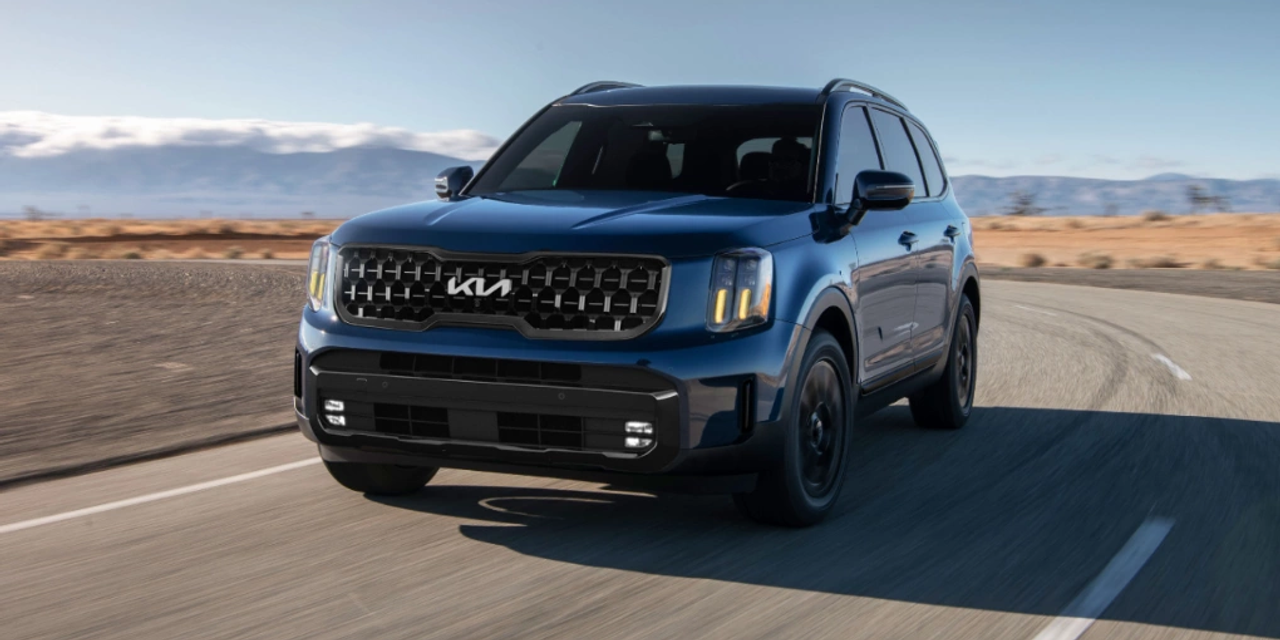Are you shopping for a 3-row midsize SUV because you think you’re still too cool for a minivan or because you need the higher ground clearance and more robust, more widely available all-wheel drive?
Either way, you’re in the market at the right time. Several compelling new, redesigned, and enhanced models have launched in the past year alone. But more good choices can mean more difficult decisions. So we rounded up six of the best and newest entries, drove them back to back on a 250-mile loop over two days, and are here to help you find a favorite.
As you consider the results, keep in mind we rate and rank vehicles based on which we deem the best choice for the most people, not all the people. That means our top-ranked entry isn’t necessarily the top choice for you. For instance, we found the refreshed Kia
000270,
Telluride and Hyundai Palisade, the totally redesigned Honda
HMC,
Pilot, and the big new Toyota Grand Highlander each outstanding in its own way, and any of them may very well be the SUV we’d recommend for you over a cup of coffee.
And, of course, we place extra importance on financial considerations like predicted resale value and historical reliability. We’re Kelley Blue Book, after all.
1st place: Kia Telluride
Kia hit a home run with the Telluride in 2019. It’s still rounding the bases in 2023.
Rating: 4.8
The Kia Telluride has claimed the segment’s top rating and our Kelley Blue Book Best Buy Award every year since its introduction for the 2020 model year. That’s four straight wins against some seriously impressive 3-row midsize SUVs.
But heading into our comparison test, the big question loomed: Does the 2023 Kia Telluride — with its mildly revised styling, new tech, and updated interior with two large digital screens integrated behind a curved glass panel — still have what it takes to remain at the top of a class that now includes a redesigned Honda Pilot and the roomy new Toyota
TM,
Grand Highlander?
Yes. Yes, it does.
The 2023 Kia Telluride is a great SUV made even better. Already a winner for its boxy and muscular presence, attractive and functional interior, and excellent tech, the Telluride upped its game on all counts for 2023. It also delivers exceptional resale value, and there’s no better warranty in the segment. It’s just so good in so many ways.
Our testing started at the business end of these family haulers. We arranged them side by side, and our seven reviewers put a magnifying glass on the rear seating accommodations and cargo areas. The Telluride impressed the group and earned solid passing grades on all fronts. The Pilot and Grand Highlander took top marks overall — with design finesse and sheer size, respectively — but the Kia and Hyundai were right there.
The Telluride began collecting more gold stars once we hit the road. Its V6 engine and 8-speed transmission delivered smooth, responsive power, and plenty of it. It proved comfortable on the highway and easy to wheel around town, with exemplary driving manners blending excellent everyday comfort with reassuring stability on curving roads. That the mechanically similar Hyundai Palisade is a bit quieter on the highway was perhaps the harshest critique leveled against the Telluride’s driving manners.
Our tallest reviewer, coming in at 6 feet 4 inches, liked that the seating position offered a tremendous forward view without leaving him feeling perched too high in the vehicle. He thought it better suited his frame than the Palisade, even.
The Telluride impressed anew in the tech department, too. With two big screens, attractive graphics, and intuitive operation, the driver information and infotainment setup earned universal praise from the group. It was also noted that the screens were easy to read in all light conditions.
Read more: Value, space, styling, safety: The 2024 Kia Telluride is tops in the 3-row midsize SUV class
And no other entry almost drove itself better than the Kia and Hyundai duo. With the latest version of Kia’s semi-autonomous driving system, Highway Driving Assist 2, we could drive for long stretches — at highway speeds and in stop-and-go conditions — with our feet off the pedals and only a light hand on the wheel. It’s the smoothest, most responsive, most confidence-inspiring system in the segment.
Long ago, Kias and Hyundais used to enjoy price advantages that couldn’t be ignored in comparison tests or the showroom. Not so much anymore. In fact, the Telluride SX Prestige X-Line was the most expensive vehicle in our test, with a sticker price of $53,825. Even so, the 2023 Telluride, with trim levels starting at $35,990, took top honors in this comparison, underscoring just how far Kia has come since the first little Sephia sedan of 1992.
—Andy Bornhop, senior editor
2nd place: Hyundai Palisade
The classy member of the midsize SUV class
Rating: 4.7
The Hyundai Palisade is the slightly more sophisticated corporate cousin to the Kia Telluride. Sharing a platform, powertrain, and tech, the Palisade distinguishes itself with a more urbane presence inside and out. But there’s only one top spot, and the Kia outranks the Hyundai here based in large part on how buyers are voting with their dollars: The Telluride has outsold the Palisade this year by about 40%. But the Hyundai is every bit as good as the Kia — it has plenty of space for passengers and cargo alike, the engine is both lively and refined, and the driver assistance features work brilliantly — and this is a case in which buyers can feel free to choose based on looks alone.
Especially in the range-topping Calligraphy trim, the Palisade is a luxury SUV without the badge, prestige, or — more crucially — the price. The best-equipped contender in our comparison, this Palisade boasts a massage function for the driver’s seat, heated seats in all three rows, and a well-considered interior with extra-soft Nappa leather upholstery. We all felt the Hyundai badges could be swapped for Genesis logos — Genesis being Hyundai’s luxury marque — and the Palisade would still impress.
One thing that isn’t so obvious but appreciated all the same, is the acoustic glass for the side windows. We found the Palisade to be exceptionally quiet on the freeway, complementing its smooth ride. As good as the Telluride is, it doesn’t get this luxurious.
The only feature to draw grumbles from multiple reviewers was the button-based transmission selector. Losing the lever helps streamline the interior, but we all agreed it’s not as intuitive as a traditional setup and takes some getting used to. Some mentioned a fondness for the column-mounted, twist-action stalk starting to make its way across the Hyundai lineup and would love to see it expand into the Palisade.
Plus: The safest new cars of 2023
From a features-for-Franklins perspective, we think the Palisade is an absolute winner. Should it turn out that a Calligraphy version would stretch the budget too far, even the base SE still has a lot of standard equipment, including many safety systems.
It doesn’t wear a luxury badge, but the Palisade is the segment’s most luxurious SUV.
—Colin Ryan, senior editor
3rd place: Honda Pilot
Let’s all say it together: ‘The new Honda Pilot does everything well.‘
Rating: 4.7
The Honda Pilot has been among our top-rated midsize SUVs for as long as we’ve been rating vehicles, and our first comparison test with the new model solidified its standing as one of the category’s elites.
The Pilot made a strong first impression during testing. In our group evaluation of rear seating and cargo areas, the Pilot was the clear favorite. The third row proved roomy and easy to access — just push a button, and the second-row seat folds and slides forward — and we all loved our tester’s removable second-row center seat. With the extra seat in place, the Pilot has seating for eight. When removed, the resulting pathway makes it easier for kids to scramble into and out of the third row, especially when child car seats are anchored into the second row. But since it stows neatly in a dedicated cubby beneath the cargo floor — instead of gathering dust in the garage — the Pilot is always ready to accommodate an eighth passenger. One of our reviewers, Eric Brandt, owns a Honda Odyssey minivan with a similar feature, and he validated its usefulness and the group’s enthusiasm.
Eric also judged the Pilot to have the most accessible child safety seat anchor points. He has four children, including a 1-year-old, so he’s the current subject matter expert when it comes to such things. For its mix of roominess, flexibility, and ease of use, the Pilot may very well be the family-friendliest 3-row midsize SUV on the market.
None of us were surprised by the Pilot’s smooth, refined driving manners, now a well-established Honda hallmark. Some of us loved the exceptionally light, quick-ratio steering, others weren’t so sure. There’s an adjustment period, but it’s hard to imagine many Pilot owners ultimately longing for heavier, slower steering.
We also found the driver assistance systems to be very good. Over our 250-mile test loop, several of us were able to let the Pilot shoulder much of the gas, brake, and steering work in a range of conditions. The Kia and Hyundai took top marks in this regard, but the Pilot also received an enthusiastic passing grade.
A smaller infotainment screen and mediocre backup camera were the only common critiques among the group.
The Honda Pilot is a highly functional 3-row SUV that’s easy and satisfying to drive and is backed by a long lineage of strong resale value and proven reliability. While the Pilot sits third on this list — outranked by the equally rated Palisade only because of the Hyundai’s lower starting price — a few editors noted the Honda would most likely get their hard-earned dollars.
—Jason Allan, principal editor
4th place: Toyota Grand Highlander
It’s kind of a big deal
Rating: 4.6
What’s a Toyota family to do when a Highlander isn’t quite big enough to accommodate their needs? Until this year, moving into a Sienna minivan was the clearest answer. Now, there’s the roomy new Grand Highlander to consider.
While the Highlander is among the smaller entries in the 3-row midsize SUV segment, the 2024 Toyota Grand Highlander is one of the roomiest. It’s about half a foot longer than the Highlander, a couple of inches wider, and boasts up to 97.5 cubic feet of cargo volume behind the front seats, vs. 84.3 for its little brother. Most crucially, with 5 additional inches of legroom, adults can now actually sit in its third row without resorting to contortionist tricks.
Our testers immediately noted the generous cargo space behind the Grand Highlander’s third-row seat but also noted the absence of any additional storage under the floor. Certainly nothing like the Pilot’s giant bin that is big enough to swallow its pop-out second-row middle seat.
At 201.4 inches in length, the Grand Highlander was the longest in our test, edging the Honda Pilot at 199.9 inches. The mother in our group appreciated the Toyota’s big, bold presence. “Having a boxier exterior helps me keep my identity and not feel like I’m driving a minivan,” said our department head, Tessa Nadik.
Inside, the Grand Highlander’s 33.5 inches of third-row legroom also turned out to be the most in this group, and those numbers translate to real-world comfort. Our resident linebacker, the 6-foot-4 Bornhop, confirmed the Toyota’s third row felt roomier than all the others. So yeah, even your growing teen should be fine back there.
Out on the road, the Toyota Grand Highlander was surprisingly enjoyable and engaging to drive. The Grand Highlander’s standard 2.4-liter turbocharged 4-cylinder engine proved more than capable enough to power this big vehicle with ease. And if you’re seeking either more efficiency or more oomph, it’s available. More than its grander size, the Grand Highlander’s other X factor is its choice of three powertrains. Beyond the standard turbocharged 4-cylinder engine, the Grand Highlander is available with a gas-electric hybrid powertrain rated to return up to 36 mpg in mixed driving. Those seeking serious power should turn their attention to the Hybrid Max powertrain that pairs the turbo 4-cylinder with an electric motor to make a combined 362 horsepower and a stout 400 pound-feet of torque.
Don’t miss: 10 new SUVs coming soon—and worth the wait
The last but certainly not least thing that stood out to us is the Grand Highlander’s safety suite. It comes with the latest 3.0 version of Toyota’s Safety Sense system (the regular Highlander is still on 2.5), which brings expected features like adaptive cruise control and lane-keeping assist.
Platinum trims like the one we tested go even further. It packs a fantastic Traffic Jam Assist system that made our time in Los Angeles’ infamous traffic far less stressful. And it can keep an eye on you — literally. A thin, almost unnoticeable camera mounted atop the steering column — the Profile Face Identification driver monitor — will alert you if it sees you taking your eyes off the road for more than a few seconds or if you seem distracted trying to find a place to park in downtown Santa Barbara (ask us how we know).
The one nit some of our editors noted about the Grand Highlander is, ironically, its size. There’s no denying it’s a big vehicle that makes its girth known in cramped parking lots. Of course, if the Grand Highlander turns out to be a bit larger than you need, well, Toyota has an answer for that.
—Matt Degen, senior editor
5th place: Nissan Pathfinder
Rugged individualism
Rating: 4.1
With superior towing capacity, a robust AWD system, and a trail-ready presence, the 2023 Nissan Pathfinder counts among the more rugged entries in the 3-row midsize SUV segment.
In our back-to-back testing, it came up short of the leaders when it comes to passenger utility, technology, and overall refinement, but not to the degree that should dissuade shoppers attracted to its unique mix of strengths.
Where most 3-row midsize SUVs top out at 5,000 pounds of towing capacity, the Pathfinder is rated to tug up to 6,000 pounds. Similarly, the Nissan’s AWD system is a bit hardier than most, with a mechanical coupling similar to traditional 4-wheel drive systems found on trucks and off-roaders. And to our eyes, anyway, those strengths are reflected in the Pathfinder’s attractive, ready-for-adventure styling.
But for shoppers who don’t need the extra capability, the Pathfinder becomes a tougher sell. We found it accelerates as well as any of the others, but with less refinement. The engine is just a bit coarser and louder, most notably when merging or passing, for instance. Our reviewers also graded the infotainment and driver assistance tech toward the bottom of the group. And aside from second-row seats that can pitch forward for access to the third row even with child car seats anchored into them, we all judged the interior not as roomy or flexible — for people or cargo — as most of the others in our test. Indeed, by the manufacturer’s measurements, the Pathfinder is the smallest entry in this test by a meaningful degree.
Read more: The 2024 Nissan Pathfinder: Rugged good looks, a well-appointed cabin and top safety ratings
The Nissan Pathfinder is a solid and recommendable 3-row midsize SUV. But its unique set of strengths and shortcomings relative to the segment’s higher-rated entries make it the right choice for a smaller set of buyers. And that’s reflected in the fact that the Pathfinder is indeed the least popular entry based on total sales so far this year.
—Russ Heaps, senior editor
You might like: The powerful 2024 Toyota Sequoia: a hybrid 3-row SUV that can tow 9,000 pounds
6th place: Ford Explorer
An aging star
Rating: 3.9
The Ford
F,
Explorer is the country’s bestselling SUV of all time. In many ways, it’s the very embodiment of the genre.
However iconic, though, the sixth-generation Explorer is now among the segment’s oldest entries. Its 2020 redesign received mixed reviews to begin with, and as we found during testing, its shortcomings are becoming more pronounced as the segment evolves.
But the Explorer isn’t without meaningful strengths, too, starting with the best fuel economy in our test. Its turbocharged 4-cylinder engine helped give our Explorer ST-Line tester the highest mpg rating, and indeed it bested the Pathfinder’s V6 by more than three miles per gallon, finishing with 23.4 mpg on the trip computer. But it was also the most powerful engine in the group, boasting 300 horsepower compared to a more typical 285-290. Not a big difference, but enough to claim the crown.
Several reviewers also appreciated just how easy the Explorer was to operate. The interior controls are uncluttered, with a shallow learning curve. The same is true of the SYNC 4 infotainment system, even if our test model had the smaller 8-inch screen rather than the optional 10.1-inch version. All things being equal, we’ll take the larger screen, but for drivers who need little more than a functional tool to control things like media, navigation, and phone connectivity, the Explorer’s setup brought a welcome simplicity compared to the more complex interfaces found elsewhere in the segment.
On the highway, the Explorer had an ace up its sleeve in the form of the Ford Co-Pilot360 Assist+ suite of driver assistance features. It’s not as robust as Ford’s BlueCruise hands-free system, but we suspect it’s benefited from that effort’s advancements and learnings.
Where the Explorer lagged was in the fundamentals. We all judged the third row less accommodating and not as easily accessed as the competition’s. And while the 2.3-liter turbocharged 4-cylinder engine impresses as one of the most powerful andmost efficient of its peers, we found power delivery comparatively unrefined. Several reviewers noted unpleasant jerkiness in the stop-and-go of city driving. We’re looking for smooth, linear acceleration and braking, and the Explorer fell short of the others. Even the automatic engine start/stop function was the most jarring. Of course, you can always turn that off, but it was a notable annoyance.
Check out: The 2024 Mazda CX-90: pricing, specs and more for this all-new, 8-seater SUV
From a driving perspective, we agreed the Explorer was at its best — better than all the others, even — when driven with gusto. Plenty of power, great steering feel, and a rear-biased AWD system combined to make the Explorer the sports car of the bunch. So if the daily drive to soccer practice includes a fun, winding road ….
The Ford Explorer is a good SUV. But in several important areas, it’s just not as good as many others.
—Eric Brandt, senior editor
This story originally ran on KBB.com.
Read the full article here







